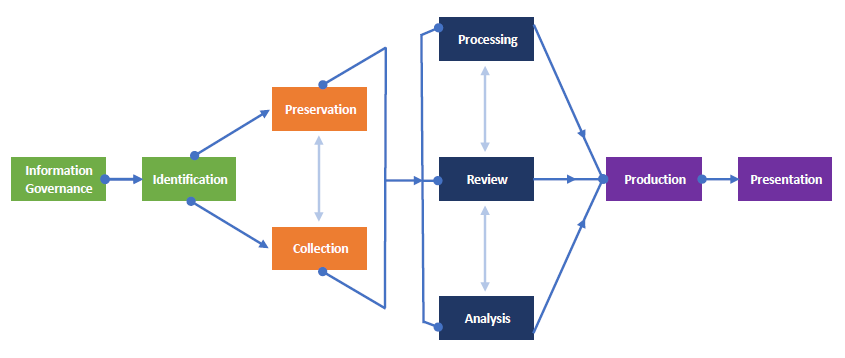Note: This blog post was originally written in Japanese for our Japanese website. We used our machine translation platform Translation Designer to translate it and post-edit the content in English. The original Japanese post can be found here.
Since we entered the 21st century, the move to globalization has progressed more and more. Everyone must have truly realized that when the Covid-19 pandemic hit the world. We all saw how economic and market movements were greatly influenced not only by our own country but also by the world. It is very appealing to be able to reach out to the global market and do business, but it is also true that there are risks involved by doing so.
Increasingly, Japanese companies are subject to local lawsuits and regulatory crackdowns where their subsidiaries operate business. When a lawsuit is filed in the United States, it is necessary to deal with electronic discovery as one of the procedures. Also referred to as e-discovery, e-Discovery, ediscovery, or eDiscovery, it is a legal proceeding for collecting and disclosing all electronically stored information, or ESI, related to the lawsuit.
In this post, we would like to give an overview of e-discovery and introduce what kind of role translation companies like us play in the process.
E-discovery workflow
In the e-discovery process, it is important to follow the workflow of an industry standard model called the Electronic Discovery Reference Model (EDRM).

The specific flow is shown in the diagram above, but it can be roughly divided into the following four stages.
1. Information governance and identification
Understanding who has relevant ESI and where they are stored, and sending relevant data owners, or custodians, a legal hold.
2. Preservation and collection
Collecting and organizing relevant ESI through data mapping, and protecting them so that they aren't altered or deleted.
3. Processing and analysis
Performing data culling such as deduplication and deleting unnecessary system data, and evaluating ESI for relevance and for privilege.
4. Production and presentation
Producing documents to be turned over to opposing counsel according to the standard specifications, and then presenting them.
ESI include files such as Office documents and, moreover, any data that is stored in an electronic form such as e-mail and chat messages. This is why, as a company, it is important to manage data appropriately on a regular basis. As you may have noticed by reading this far, e-discovery involves not only legal procedures but also many IT-related processes.
In addition, the relevant ESI are not limited to those located in the United States — data stored in Japan or anywhere else in the world can also be considered as relevant ESI. That means you will need translation work for these.
Translation companies are part of your resources
Since the e-discovery process requires quick processing of huge amounts of data, the key is to make good use of software, tools, and the help of experts.
As an expert of translation, translation companies like us can provide support mainly for "preservation and collection" and "processing and analysis" among the four stages mentioned above. However, not all translation companies are capable of providing e-discovery translation services. In order to translate a large amount of relevant ESI in various file formats, it is essential to have the technical capabilities and know-how to handle them.
So, what exactly makes a translation company capable of handling e-discovery translation projects? We would like to share the actual efforts being made at Kawamura International as an example.
Leveraging language technology
It is important to quickly identify and prepare relevant ESI in the e-discovery process. To achieve that, it is necessary to check the data content as soon as possible and sort them out. In terms of quality, human translation is the best. However, what is required for sorting the data is not the best translation but rather a translation that enables you to at least understand the content.
To save time and costs, the suitable translation method for this situation is machine translation with post-editing. At Kawamura, we test various machine translation engines to select the most effective one for the content and have professional linguists edit the machine translation output.
Fully using the translation data is also essential. As we translate, we will simultaneously create a database of the translated content to maximize our translation productivity and efficiency. Unless we significantly reduce the work time, it's impossible to keep up with the fast-paced translation required for e-discovery projects.
Automating the process
The data volume handled in e-discovery projects is a daunting scale, with millions of characters and thousands of files. Process automation is inevitable for processing data.
For example, email message files cannot be imported for machine translation as is and must be converted to another file format. If you handle this manually, it will take forever and you might even accidently delete or alter the data.
One of the effective approaches here is to automate the process by incorporating tools like Microsoft Power Automate. You can create an automated workflow that converts email message files to another file format such as html files.
Working with a wide variety of file formats
When we talk about relevant ESI, they are not just files originally created in electronic format. They may also include photos of handwritten notes or scanned PDFs of reports with handwritten signatures. Again, these photos and scanned PDFs cannot be imported for machine translation as is since they are recognized as images and text information are not readable.
In this case, we utilize the optical character recognition (OCR) technology to mechanically transcribe them and then process the machine translation. We are able to work with any type of data — thanks to our dedicated engineers who make this possible. It's important to ensure that the translation process is uninterrupted no matter what files are provided.
Secure environment
In the e-discovery process, you will be submitting trade secret data and content if they are identified as relevant ESI. Needless to say, data security management is vital to handle such sensitive data. At Kawamura, we are ISO 27001-certified, which is an international standard for information security management.

Summary
E-discovery is a legal proceeding for collecting and disclosing all relevant ESI related to a lawsuit when it is filed in the United States. Lawsuits are very expensive and time consuming. And, it is said that the e-discovery process accounts for a large proportion of that time and money. As businesses go global more and more, there is no doubt that being prepared for future e-discovery requests is important and something worth considering.
Kawamura's translation services
Kawamura International has many years of experience in providing professional translation for specific industries such as IT, tech, manufacturing, medical devices, life sciences, and legal services. We also have a dedicated team of engineers who develop language-specific technology and provide technology solutions.
As a translation and language technology expert, Kawamura will support your translation process needed for e-discovery.
We offer unique e-discovery translation solutions backed by our experienced team providing machine translation with post-editing services for large-scale projects. Combined with our AI-powered language solutions that boost our translation capabilities, we can surely make a difference in your e-discovery planning. Feel free to reach out to us for any questions or an estimate for potential projects.
_CMYK_OL.png)


